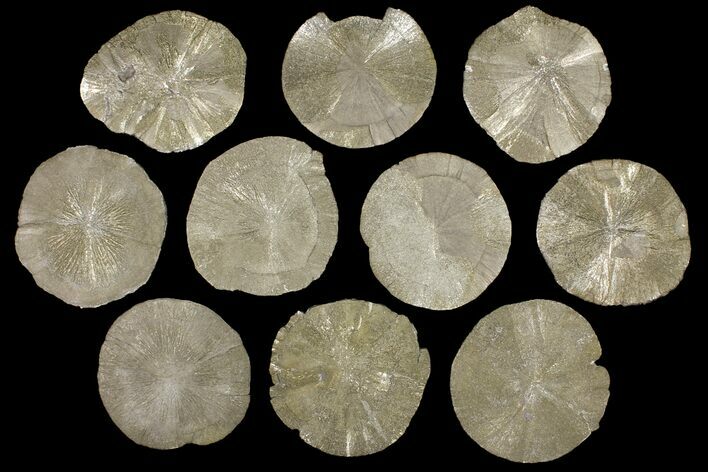This Specimen has been sold.
Lot: 3.5" Pyrite Suns From Illinois - 10 Pieces
This is a wholesale lot of 10 shiny pyrite suns collected from the coal mines in Sparta, Illinois. These are natural pyrite formations and all the pieces range from 3.5 to 4" across.
At the wholesale lot price, each sun is $12.5 and they can easily retail for 2-3x that price. You will receive the exact pieces pictured.
At the wholesale lot price, each sun is $12.5 and they can easily retail for 2-3x that price. You will receive the exact pieces pictured.
About Pyrite Suns
Pyrite suns or pyrite dollars are an unusual pyrite formation: striations radiate out from the center like rays of the sun. They are found in narrow, compacted seams of slate interbedded in the 300 million-year-old coal deposits near Sparta, Illinois. They are recovered as a byproduct of local coal mining operations, but are increasingly difficult to source as the coal mines in Illinois shut down one by one.
People used to believe that pyrite suns were fossils that had undergone pyrite replacement. The current consensus is that they are simply formed due to the enormous pressure compacting the slate, and causing pyrite to grow laterally in a radiating manner.
The mineral pyrite, or iron pyrite, is commonly referred to as Fool's Gold because its metallic luster and pale brass-yellow hue give it a superficial resemblance to gold. In the old mining days, pyrite was sometimes mistaken for gold. Pyrite is the most common of the sulfide minerals with the chemical formula FeS2. Its crystals occur in many shapes and habits, including cubes of all sizes, penetration twin cubes, pyritohedral clusters, and as small druzy crystals that can exhibit a beautiful glistening effect.
Pyrite suns or pyrite dollars are an unusual pyrite formation: striations radiate out from the center like rays of the sun. They are found in narrow, compacted seams of slate interbedded in the 300 million-year-old coal deposits near Sparta, Illinois. They are recovered as a byproduct of local coal mining operations, but are increasingly difficult to source as the coal mines in Illinois shut down one by one.
People used to believe that pyrite suns were fossils that had undergone pyrite replacement. The current consensus is that they are simply formed due to the enormous pressure compacting the slate, and causing pyrite to grow laterally in a radiating manner.
The mineral pyrite, or iron pyrite, is commonly referred to as Fool's Gold because its metallic luster and pale brass-yellow hue give it a superficial resemblance to gold. In the old mining days, pyrite was sometimes mistaken for gold. Pyrite is the most common of the sulfide minerals with the chemical formula FeS2. Its crystals occur in many shapes and habits, including cubes of all sizes, penetration twin cubes, pyritohedral clusters, and as small druzy crystals that can exhibit a beautiful glistening effect.
 Reviews
Reviews












